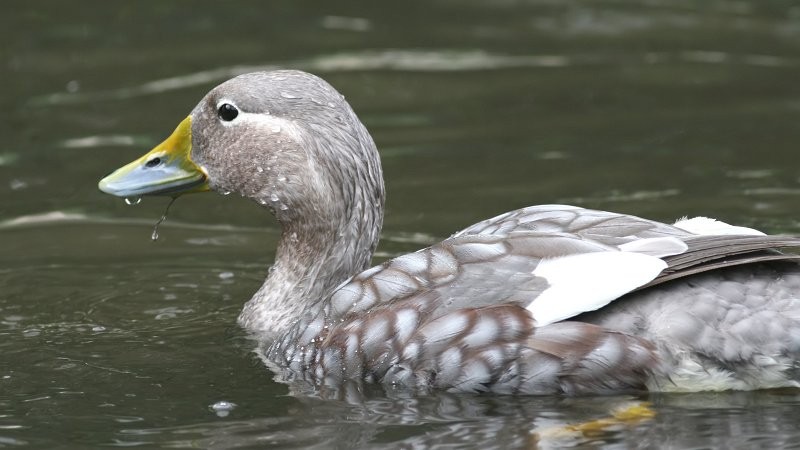Flying Steamer Duck
A species of Steamer ducks Scientific name : Tachyeres patachonicus Genus : Steamer ducks
Flying Steamer Duck, A species of Steamer ducks
Botanical name: Tachyeres patachonicus
Genus: Steamer ducks
Content
Description General Info
 Photo By Ken Billington , used under CC-BY-SA-3.0 /Cropped and compressed from original
Photo By Ken Billington , used under CC-BY-SA-3.0 /Cropped and compressed from original Description
Though they are the smallest of the four Tachyeres species, flying steamer ducks share similar plumage traits with other steamer ducks including brown head and neck feathers with white stripes stretching from their eyes to the napes of their necks, and brown-gray gradient body feathers. Their underbellies are mostly white, and their feet are orange. Female flying steamer ducks have smaller bills relative to males that are orange with black tips, while males have darker gray bills with slight yellow accents. Flying steamer ducks are also sexually dimorphic to the extent that males are heavier but have smaller cranial elements and wingspans than females. Males and females both possess cornified orange carpal knobs on the proximal part of the carpometacarpus bone, and these knobs are used in display as well as interspecies and intraspecies combat by males. Sexual dimorphism can also be observed in the duration and pitch of their various calls, which sound much like grunts. The females’ grunts have been described as lower pitched than the males’ grunts, and usually occur in rapid succession of similar pitch. Males have three distinct grunts that have been described as whistle-like, including a ‘rasping’ grunt, a ‘ticking’ grunt, and a ‘sibilant’ grunt. Flying steamer ducks undergo three molts per annual cycle, and these molts vary widely with geographic location. The wear and degradation on the primary and secondary feathers of observed flying steamer ducks varies depending on the location and flight behavior of the individuals. 
Size
71 cm
Nest Placement
Ground
Feeding Habits
Flying Steamer Duck primarily forage in pairs, diving in deep-water kelp beds or shallow areas, with consistent dive initiation within pairs. Their diet includes mollusks, crustaceans, and marine invertebrates, though specific prey species are not well-documented.
Habitat
Flying Steamer Duck's habitat spans diverse aquatic environments at the southern tip of South America. They thrive around both freshwater sources—like inland lakes and rivers—and marine areas, particularly rocky coastlines and estuaries. Their evolutionary history of versatility has persisted, enabling flying Steamer Duck to adapt to various water bodies and ensuring a wide distribution unlike some flightless relatives.
Dite type
Omnivorous
General Info
Feeding Habits
Bird food type
Distribution Area
Flying steamer ducks inhabit aquatic areas at the southern tip of South America, specifically Chile and Argentina, Tierra del Fuego, and the Falkland Islands. Genetic comparisons of Falkland Island steamer ducks suggest the species diverged from continental steamer duck species between 2.2 and 2.6 million years ago, coinciding with a proposed land bridge that may have once connected the Falkland Islands to the mainland. The three steamer duck species that inhabit the mainland share a common ancestor roughly 15,000 years ago, and the species show genetic differentiation as well as different stages between flightless-ness and flying ability. For this reason, steamer ducks have been praised as an excellent potential genus for studying the evolution of flightless-ness in birds. Flying steamer ducks are widely distributed compared to other steamer duck species, likely due to their flying ability, and have been observed to reside in both freshwater and marine environments throughout Chile, Argentina, and the Falkland Islands. 
Species Status
The flying steamer ducks are not an endangered species and are categorized as a Least Concern species, however increased nest predation of flightless steamer duck nests by American minks was reported to be a potential future threat to duck populations in Tierra cel Fuego wildlife areas. 
Scientific Classification
Phylum
Chordates Class
Birds Order
Waterfowl Family
Geese Genus
Steamer ducks Species
Flying Steamer Duck